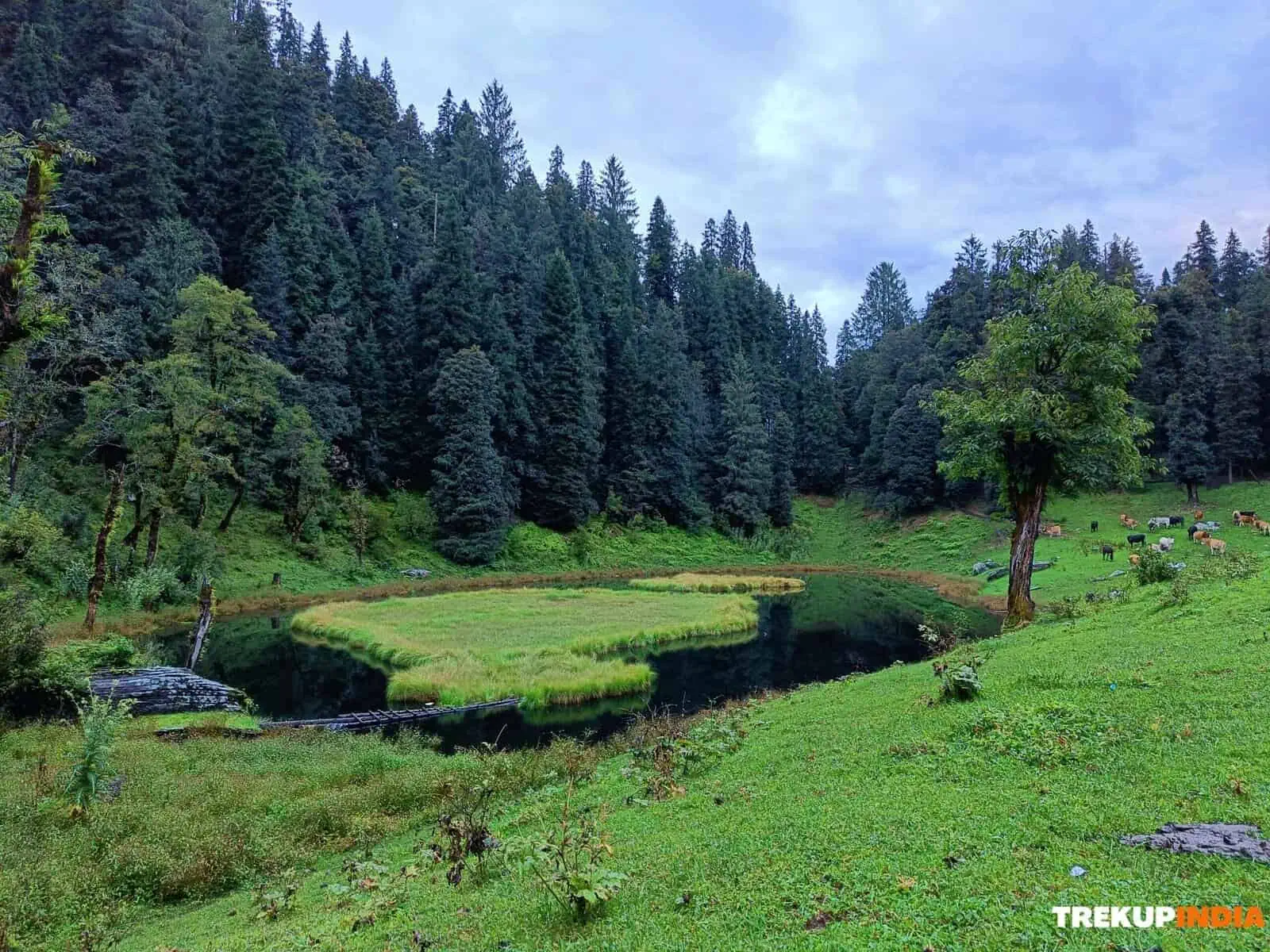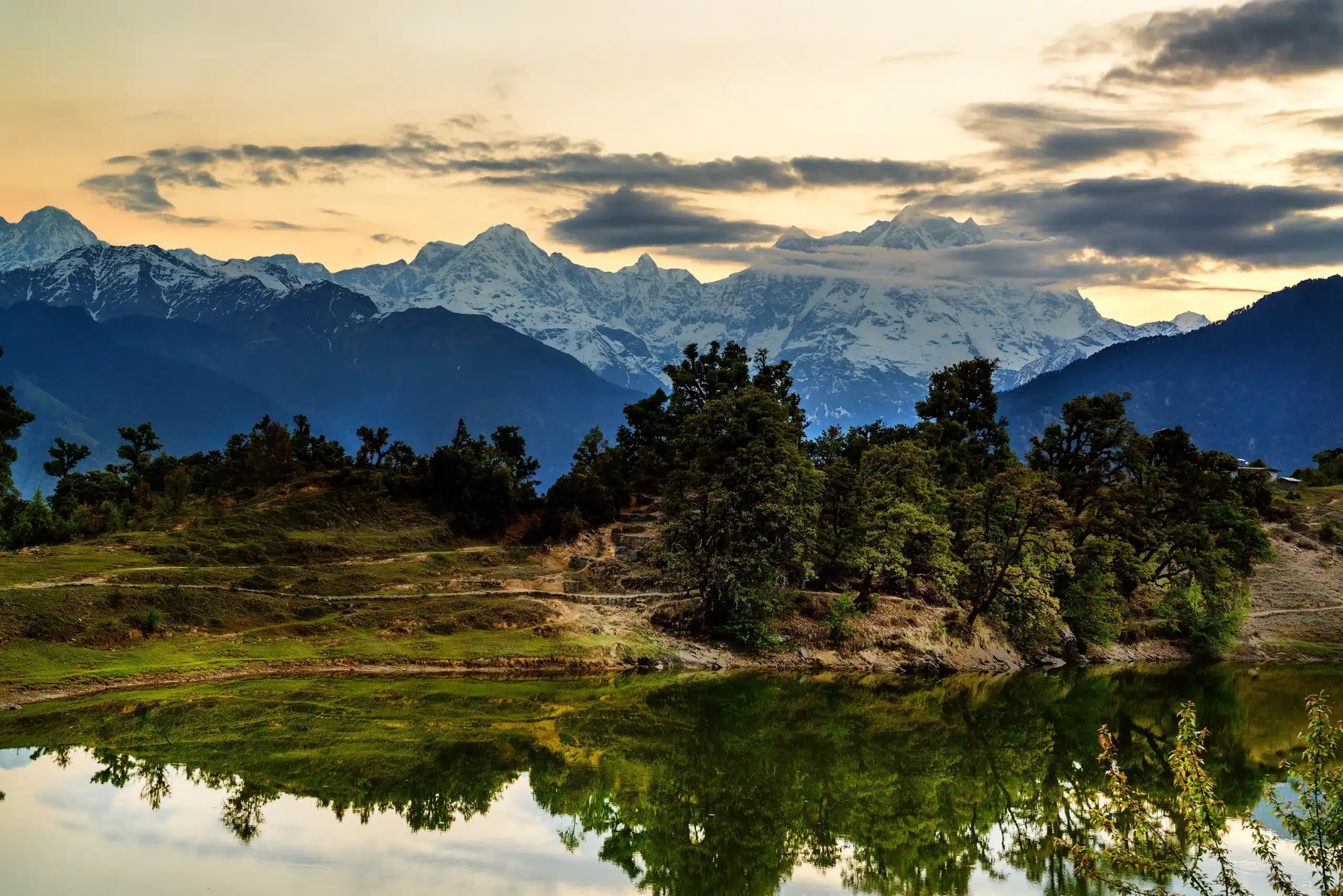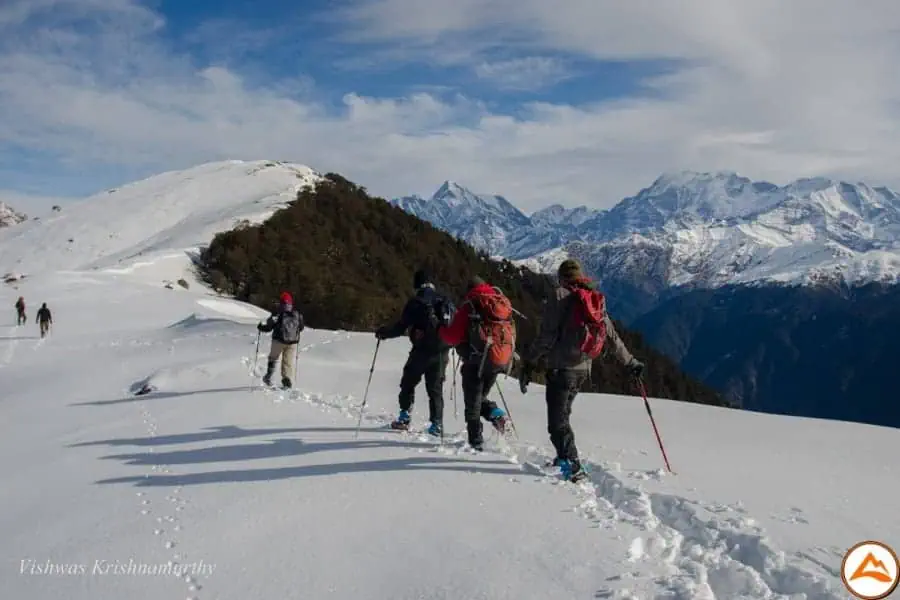Trek Grade
Moderate
Highest Altitude
12950 ft
Base Camp
Sepi
Best Time
Autumn, Summer, Winter, Spring
Trek Distance
68 Km
Sandakphu Trek
Sandakphu Trek lies in the Darjeeling district of West Bengal; on this trek, you can expect to experience the breathtaking vistas of the world’s tallest peaks. The Level of this trek is moderate to difficult, suitable for people with prior experience; first-time trekkers can also do this. Picturesque views of the snow-capped peaks of Nepal, Bhutan, and east of Tibet are the scenery that awaits on this trek. Since this trek falls under the Singallia National Park, you can witness this region’s rich vegetation and fauna.
The Sandakphu Trek is a unique adventure that combines the stunning sight of four of the highest mountains on Earth with a harmonious blend of nature and culture. As you stand at Phalut, take in the breathtaking view of the Everest cluster, comprising the fourth- and fifth-highest mountains globally, Lhotse and Makalu. This unique vantage point offers a rare opportunity to behold these three magnificent peaks together, a truly unforgettable experience.
The majestic “Sleeping Buddha” mountain range, located on your right, is truly awe-inspiring. Its uncanny resemblance to a peaceful, slumbering figure is a sight. The impressive massif boasts the third-highest mountain in the world, Kanchenjunga, which stands out as the most prominent peak in this distinctively shaped range. As you wake up at our Sabalgram campsite, you will be greeted by the mesmerizing Sleeping Buddha, a sight that often evokes strong emotions in hikers.
Sandakphu-Phalut holds a special place in our hearts when experiencing breathtaking sunrises and sunsets. The sunset we witness from Aahl is genuinely remarkable and incomparable. It is a peculiar phenomenon of nature where a vast expanse of clouds settles beneath Aahl, resembling waves in the sea. Within this enchanting cloud-filled atmosphere, the sun gradually sets, casting a mesmerizing glow. The sight of the Everest cluster and the Sleeping Buddha, shining in vibrant shades of orange, adds an emotional touch to these unforgettable moments during the trek.
The primary motivation for embarking on this trek is to witness the breathtaking sunrises and sunsets. Based on our past experiences, we have yet to come across treks offering magnificent views of the sun’s ascension and descent. Our hikers particularly adore the Singalila National Park. Its bamboo and rhododendron forests are incredibly dense and awe-inspiring.
North of Samanden, an expansive stretch of bamboo grows, forming a canopy that invites visitors to immerse themselves in a unique experience. As they walk beneath the towering, dense stalks, the sun’s rays are filtered through the leaves, casting a soft, emerald glow. The closely packed bamboo creates an enchanting atmosphere, transporting those who venture into this hidden realm to a world of wonder and magic.
While it’s uncommon, it’s not impossible to catch a glimpse of the majestic Himalayan black bear, red panda, and clouded leopard during the trek. Additionally, we’re excited to immerse ourselves in the rich Indo-Nepali culture that permeates the region. As we make our way through the mountains, our route takes us across the border between Nepal and India, with our sleeping tents set up in India and our kitchen tents in Nepal at some camps.
The proprietors of the local tea houses, who are often families, are renowned for their hospitality and warmth. Upon entering one of these cozy establishments, visitors are welcomed with a steaming cup of tea and a heartfelt smile. The influence of Buddhism is palpable and pervasive.
The food combines elements from both Nepali and Tibetan traditions. We love Bhukiya roti, a delicious bread. It pairs perfectly with our homemade fruit jams. Additionally, we have a particular fondness for Nepali Thukpa, which is distinct from the version found in our cities. Remember to bring back Dalle Khursani, one of the spiciest chillies in the world, as a souvenir. Lastly, don’t forget to include bamboo shoot pickles and Churpi (yak cheese) on your list of souvenirs to complete your collection.
At this remarkable height, you would see the Buddha Formation and the sight of Mount Everest, Kanchenjunga, and various other snow-covered peaks. The vibrant biodiversity found in the region includes Magnolias and Rhododendrons, which are very beautiful and add to the scenic picture-perfect landscape. This hamlet is studded with local wooden huts and spread-out farmlands. This trek also follows the Old Silk Route, where the trail leads through bends, loops, and lush natural beauty, along with the hospitality of the locals.
Trek Cost
- Stay will be on a twin-sharing basis in tents
- + 250 Trek Insurance (Optional)
- Discount Policy
- Transport Optional ( INR - 2,500 extra )
Pickup Point Will be from New Jalpaiguri or NJP and pickup time will be 9.30 AM. Drop NJP by 6 P.M on the final day.
Fix Departure Dates
Sandakphu Phalut Trek Videos
Videos by experts watch these videos to prepare well for a Successful Trek

Want To Trek Like Pro?
Check out the following videos if you want to trek like a pro trekker and improve your skills. These videos contain helpful tips, tricks, and techniques to help you trek like a pro. Whether you’re a beginner or an experienced trekker, these videos can provide valuable insights to enhance your trekking experience. So, watch the videos below by Trekup India experts to take your trekking skills to the next level.




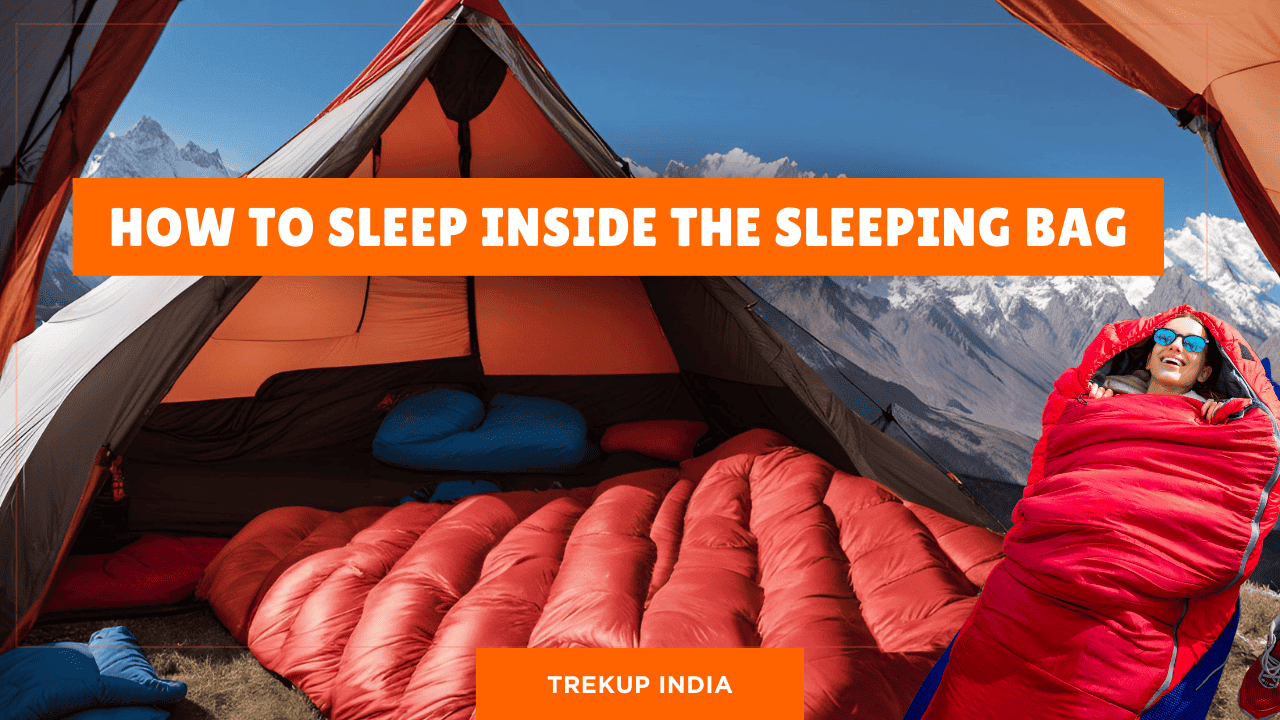


Know Everything About Acute Mountain Sickness
Acute Mountain Sickness is a medical condition that can occur when individuals travel to high altitudes, typically above 8,000 feet. It is caused by the decrease in air pressure and oxygen levels in the air as altitude increases. Symptoms of Acute Mountain Sickness may include headache, nausea, vomiting, dizziness, and difficulty sleeping. To avoid Acute Mountain Sickness, it is important to gradually adjust to high altitudes and seek medical attention if symptoms worsen. To learn more about this condition, check out the videos by Trekup India.

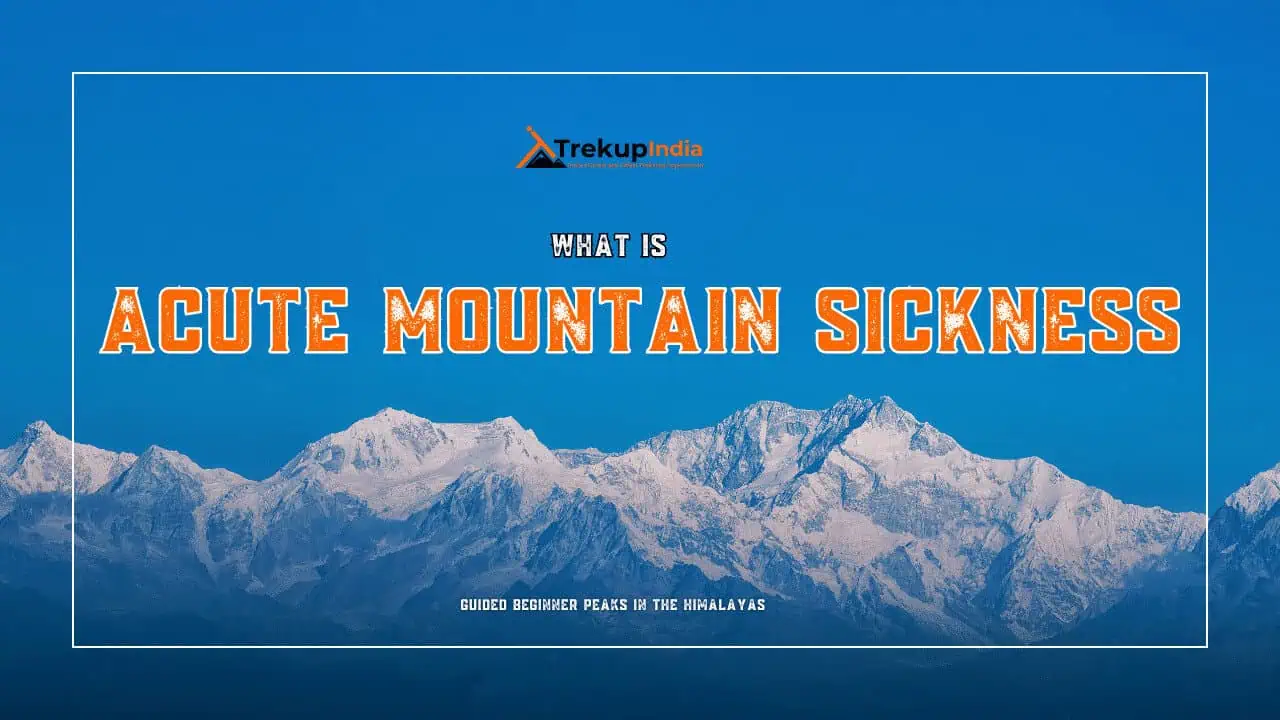
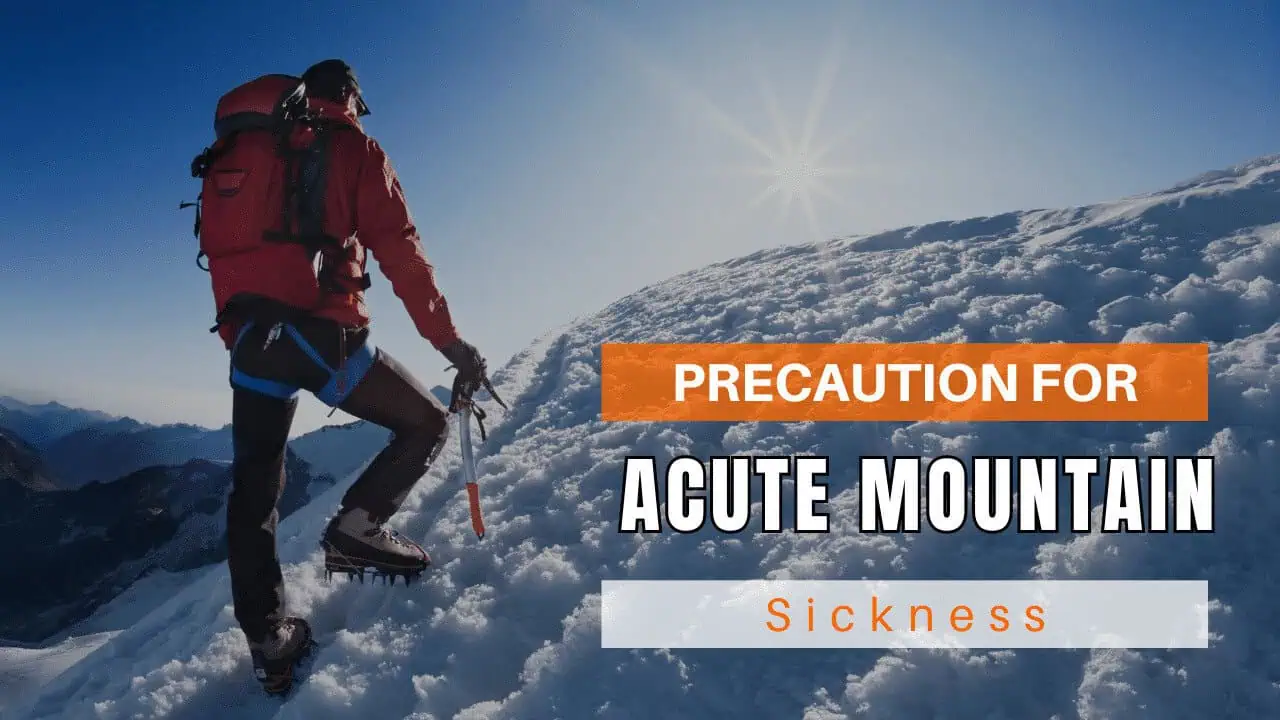
Day Wise Detailed Itinerary of Sandakphu Trek
Day 1: New Jalpaiguri (NJP) to Sepi by Drive
- Altitude: New Jalpaiguri (NJP) Railway Station (374 ft / 114 meters), Sepi (6400 ft / 1951 meters)
- Altitude Difference: 6026 ft / 1837 m
- Drive Distance: 130 km
- Drive Duration: Approx. 7 hrs
- Stay: Overnight stay at the teahouse.
- Meal: Dinner
The trekkers would begin the journey from New Jalpaiguri (NJP) to Sepi; on the road, they would pass through the famous tea gardens of Darjeeling and Sikkim. After we had begun the drive, the first place we would reach was Mirik, which is a famous tourist destination. On route, we would pass by some picturesque, charming villages like Rimbik, Sukhipokhri and Dhotrey. The stop point of today’s trek is Sepi, an impressive place surrounded by greenery. There is also a Srikhola spring in Sepi village, which makes the landscape more beautiful. Upon reaching it, we would rest after the tiring, long drive.
Day 2: Sepi to Gorkhey via Raman-Samanden by Trek
- Altitude: Sepi (6400 ft / 1951 m), Gorkhey (7874 ft / 2400 m)
- Altitude Difference: 1474 ft / 449 m
- Trek Distance: 15 km
- Trek Duration: Approx. 8 hrs
- Stay: Overnight stay at the teahouse.
- Meal: Breakfast, Lunch, and Dinner
- Trek Grade: Gradual
It is the second day of your travel and the first day of your trek, so that trekkers will be given a delicious breakfast in the morning on this day. The trekkers would be passing through the famous Darjeeling tea garden. From the beginning of the trek, the trail gradually climbs uphill, followed by some steep sections until we reach Raman. At the beginning of the trail, you would be crossing fields and small huts on the way. But as you proceed, the huts will disappear, and you will start seeing pine and oak forests. The trekker would find dense forest as the region falls under the Singalila Range, which is well known for abundant greenery. The trekker would then cross a bridge, after which lies an area where locals have dedicated stone benches for the people who have passed away. As the trekkers move further, they would again see farmlands and wooden huts, which means they have reached Samanden village. From Samanden village, it is just a few kilometers till you reach Gorkhey, which would be the resting place for the day.
Day 3: Gorkhey to Phalut by Trek
- Altitude: Gorkhey (7874 ft / 2400 meters), Phalut (11,800 ft / 3600 meters)
- Altitude Difference: 3926 ft / 1200 m
- Trek Distance: 15 km
- Trek Duration: Approx. 7 hrs
- Stay: Overnight stay at the teahouse.
- Meal: Breakfast, Lunch, and Dinner
- Trek Grade: Gradual to Moderate
Begin your morning with hot tea and the glorious view of the mountains before you. When the trekker is ready for the day’s trek, they begin walking along the gorgeous Gorkhey Khola, which flows out of Ramam River and passes through Gorkhey village. The trail would then pass through Oaks, Bamboos, and Rhododendron Forest, and at some places, the trail could be steeply uphill. Soon, you will reach Phalut, one of the highest peaks in the Singalila Range and the second-highest point after Sandakphu Ridge. “Sleeping Buddha” is the name of the four tallest mountain peaks in Phalut. Gorkhey is a small village with fields and rivers flowing at the bottom. Here, you could also experience the warmth of the local culture and lifestyle of the quaint little village.
Day 4: Phalut to Thakom by Trek
- Altitude: Phalut (11,800 ft / 3600 m), Thakom (11,300 ft / 3444 m)
- Altitude Difference: 500 ft / 156 m
- Trek Distance: 10 km
- Trek Duration: approx. 7 hrs
- Stay: Overnight stay at the teahouse.
- Meal: Breakfast, Lunch, and Dinner
- Trek Grade: Gradual to Moderate
On this day, you would be trekking where the Sleeping Buddha formation would be in the background. In today’s trek, you will cross the Indo-Nepal border to reach Nepal. Thakom is a beautiful valley between Sabargram and Sandakphu, a beautiful combination of beautiful meadows and a picturesque landscape setting. On this trek, you would see some Yaks grazing in the meadows; the trail is further remote and unknown location. You will see Rhododendron trees as you reach the day’s stopping point. Upon reaching the stopping point, Trekup India’s high-altitude chief will prepare a delicious dinner for you.
Day 5: Thakom to Aal by Trek
- Altitude: Thakom (11,300 ft / 3444 meters), Aal (11,500 ft / 3505 meters)
- Altitude Difference: 200 ft / 61 m
- Trek Distance: 11 km
- Trek Duration: Approx. 7 hrs.
- Stay: Overnight stay at the teahouse.
- Meal: Breakfast, Lunch, and Dinner
- Trek Grade: Gradual to Moderate
The beautiful sunrise awaits you as you wake up in the morning with scenic views of the mountains. All is also the closest campsite to Sandakphu summit; today’s trek will not be as tiring as the previous days. Furthermore, on this trek, you would also catch sight of the Kanchenjunga ranges and other peaks. From here, you would be closely seeing the Sleeping Buddha formation. You would get ample rest at Aal before the next day’s trek.
Day 6: Aal to Timbure via Sandakphu by Trek
- Altitude: All (11,500 ft / 3505 meters), Sandakphu (11,930 / 3636 meters), Timbure (6550 ft / 1996 meters)
- Altitude Difference: Aal to Sandakphu (430 ft / 131 meters), Sandakphu to Timbure (5380 ft / 1640 meters)
- Trek Distance: 14 km
- Trek Duration: approx. 6 hrs
- Stay: Overnight stay at the teahouse.
- Meal: Breakfast, Lunch, and Dinner
- Trek Grade: Gradual
Today marks a long trekking day; begin the morning with a warm breakfast and hot tea. The trekker would reach from Aal to Sandakphu in a few hours, where you could enjoy the sunrise if you wake up early. From Sandakphu, you will see snow-covered peaks such as Makalu, Lhotse, Everest, Nuptse, Baruntse, Chamling, Chomo Lonzo, Machapuchare, and others. After spending ample time at the top, you would begin your downhill climb towards Timbure. The first village you would be crossing by is Gurdum, which is a picture-perfect dwelling surrounded by Himalayan mountains. Upon reaching Timbure, you would be either staying at the teahouse.
Day 7: Timbure to Srikhola by Trek, Srikhola to New Jalpaiguri (NJP) by Road
- Altitude: Timbure (6550 ft / 1996 meter), Srikhola (6900 ft / 2103 meter), New Jalpaiguri (NJP) Railway Station (374 ft / 114 meter),
- Altitude Difference: Timbure to Srikhola (440 ft / 107 meters), Srikhola to New Jalpaiguri (NJP) Railway (6526 ft / 1989 meters)
- Trek Distance: Timbure to Srikhola by Trek (3 km), Srikhola to New Jalpaiguri (NJP) by road (130 km)
- Trek Duration: Timbure to Srikhola by Trek (approx. 1 hr), Srikhola to New Jalpaiguri (NJP) by road (approx. 6 hrs)
- Stay: Overnight stay at the teahouse.
- Meal: Breakfast, Lunch, and Dinner
- Trek Grade: Gradual
This is the last of your journey and trek; this would be the last when you would be up close to the mountains. You will begin your trek from Timbure to Srikhola, which will take approx. one hour. From Srikhola, you would begin road travel to New Jalpaiguri (NJP) Railway Station, where a Trekup India Representative would drop you off. As you reach New Jalpaiguri (NJP) Railway Station, the Trekup India Team will bid you farewell, and you will be on your own to either proceed towards your home or you could explore the nearby places.
We’ve prepared a comprehensive Trek Route Map for your upcoming adventure to Sandakphu Phalut Trek, which outlines the entire journey including all stops and trails. This map provides detailed information on the terrain, distance between points of interest, and estimated travel time to help ensure a safe and enjoyable trek. We’ve carefully curated the map to ensure that you have all the necessary information at your fingertips. Please take a moment to review it thoroughly, and don’t hesitate to reach out if you have any questions or concerns.
The Sandakphu Trek Altitude Chart is a useful tool for Trekkers to monitor their altitude changes during their rides, allowing them to plan their routes more efficiently and track their progress over time. This altitude chart is beneficial for both casual and experienced trekkers, helping them make the most out of their trek experience.
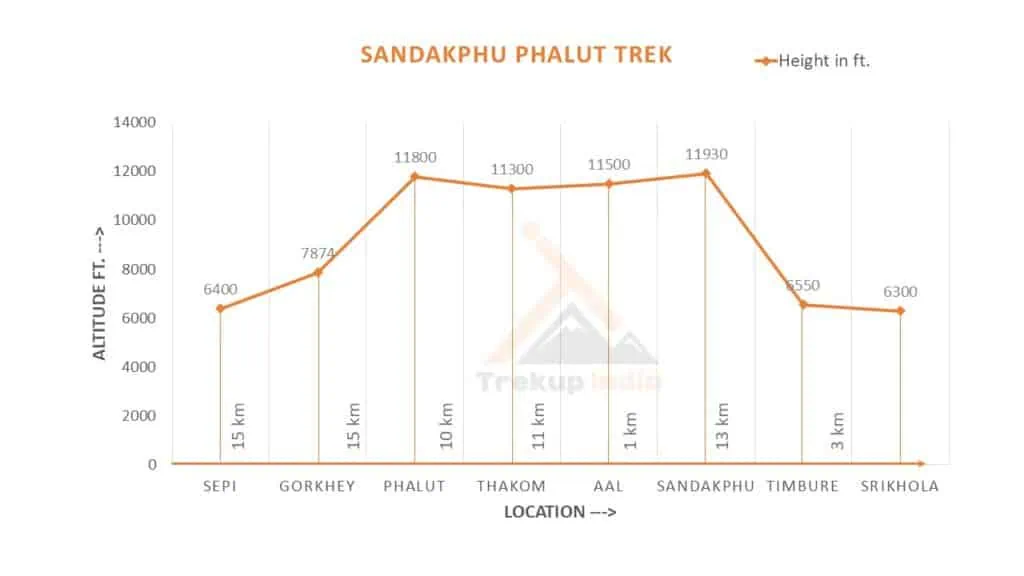
Trek Cost Inclusions
- Stay: 6 Nights of Tea House, Guest house accommodation at individual campsites of Trekup India on twin sharing.
- Meals: Trekup India will provide freshly cooked meals during the trek starting with Dinner on Day 1 to tea, coffee on day 7 (Meals are simple, nutritious, and vegetarian)
- Transport (Optional): NJP to Sepi and return. ( 2,500 extra )
- Trek Insurance (Optional): Trekup India recommends that all trekkers consider getting trek insurance. This is optional, but highly recommended. Trek insurance covers unexpected events that may occur during your trek. The cost of the insurance starts from INR 210. Please read more about what is included in the coverage and why it is mandatory on treks.
- Trek Equipment: Sleeping bag, Sleeping tents, Kitchen tent, Dining tent, Toilet Tent.
- Amenities: All utensils, sleeping mattresses (Black foam mats), Crampons, and Gaiters for snow.
- Health & Safety: First Aid Box, Oxygen Cylinders, Stretchers, Oxi meters, BP Machines, health.
- Permits: Forest Permits and Camping Permission Fee
- Trek Crew: High Altitude Chef, Helpers, Trek Leader & Guides, and other support teams.
- Potters & Mules: Potters and Mules are to carry all trekking equipment, ration, and vegetables.
Trek Cost Exclusions
- GST 5% (it is Mandatory)
- Any Meals/accommodation beside the itinerary or not mentioned in the program.
- Any Bus / Airfare to/from trek start/end point
- Personal Medical expenses do carry your medication.
- Any personal services such as Laundry, phone calls, liquors, mineral water, etc.
- Any still / video camera fee
- Any Entrance fee Monuments, Monasteries, Museums, Temples – Pay directly on the spot.
- Mules or porter charges to carry private baggage (Offload Charges for bag 365 per day, per bag if paid online (at base camp 2,550). Note: Bag weight should not be more than 10 kg.
- Any emergency evacuation charges
- Any services that are not mentioned in the cost inclusion section.
What should you pack for the Sandakphu Trek
Sandakphu Trek is a high-altitude trek. The trekking gear you have to have for this particular trek differs from normal treks. Thus, read this whole segment. There is an important question that the trekker who is doing trek asks, like what all things to carry while trekking. Below, we have provided the details on everything you should take; an easy way to remember is by Head to foot or foot to head. We have prepared from Head to foot.

Head Gears
When trekking it's important to carry headgear to protect your head and face.
Heading out for a trek? Don’t forget to carry headgear to protect your beautiful face and head from the sun, wind, and dust! It’s an essential accessory that keeps you safe and comfortable throughout your adventurous journey. So, make sure you pack it before you step out into nature!
- Head Lamps – When trekking at night, headlamps are essential to illuminate your path while keeping your hands free. Headlamps come in different sizes and lumens, so it is essential to choose one that suits your needs.
- Hats or Cap – Caps or hats are also necessary when trekking in different weather conditions. Caps protect your head from the wind and freezing temperatures at night, while hats provide shade and protection from the sun during the day. It’s essential to ensure that your hat has a strap to prevent it from being blown away by the wind.
- Sunglasses – Sunglasses are also essential for trekking. Your sunglasses should protect your eyes from harmful UV rays and fit your face perfectly to avoid falling off while climbing, jumping, or crossing obstacles. The glass of your sunglasses should also be designed for different weather conditions to provide optimal visibility.
- Buff / Balaclava – Lastly, a buff or balaclava is a must-have to protect your mouth or neck from extreme temperatures and keep them warm. Buffs and balaclavas come in different materials, thicknesses, and designs, so it’s important to choose one that suits your needs and preferences. Depending on the weather conditions and your activities, you can wear them as neck warmers, face masks, or headbands.
Clothes
When trekking in high altitudes, prepare for cold weather by wearing layers. Layering traps heat, keeps you warm, and allows you to easily adjust your clothing as temperatures fluctuate.
Layering is important for different seasons when trekking. When planning a high-altitude trek, it is important to prepare for the cold weather. Wearing layers is the best approach as it provides both protection and flexibility when the weather changes frequently in the mountains. Layering helps to trap heat and keep your body warm, while at the same time allowing you to easily adjust your clothing as the temperature fluctuates. By wearing layers, you can enjoy your trek comfortably and stay safe in the unpredictable mountain weather
- For spring, summer, and monsoon treks, consider wearing three layers: a woollen sweater, a fleece, and a padded jacket.
- For autumn treks, add one more fleece layer to make it four layers.
- For winter treks, you may need five layers with thermals, a woollen sweater, two fleeces, and a padded jacket.
- T-shirt/sleeve shirt– Bring three T-shirts and two quick-dry trek pants, wearing one and carrying the others. Long sleeve shirts help to protect from sun UV rays. We recommend synthetic T-shirts as they get dry quickly when they get wet.
- Hiking / Trekking Jacket– down jackets (-5 to-10 C) or two-three-layer jackets.
- Thermals– at least two pairs of thermals help keep the body warm during cold weather.
- Undergarments– you can carry them according to your habitual and hygiene requirements.
- Gloves– 1 pair of gloves will keep your hand warm and nice.
- Trek Pants– Bring 2 to 3 comfortable trekking pants. Trekking pants play a significant role, as they are designed for comfort and mobility, making trekking easier. It should be Synthetic so that it gets dry quickly when wet.
- Rain Wear– you can carry a raincoat or Poncho. During long rains and snowfalls, the waterproof jackets start leaking. Still, the Poncho and raincoats keep you dry, so choose accordingly.
Tip: If you choose a raincoat on your trek, carry a small waterproof cover so things inside your backpack can’t get wet. If you carry a Poncho, you don’t need to worry. It protects both you and your backpack.
Foot Gears
When it comes to planning a trek, one of the most important aspects is to ensure that you have the right kind of foot gear.
- Trekking shoes which are waterproof and have ankle support. Walking / Hiking sandals which can be used off the trek, i.e., in the morning and evening hours when you reach the campsite, basically to get your feet rest from heavy boots, sometimes used for crossing streams and rivers, it’s more comfortable and safer than crossing barefoot or wetting your shoes. Sneakers (Optional) can be worn for normal driving days or used around the camp.
- Socks– you should at least carry 3 to 4 pairs.
- Microspikes & Gaitorswill be provided by Trekup India when required. You don’t have to carry them.
Personal First Aid Kit
Don't forget to pack your personal first aid kit! It's always better to be safe. So, make sure you're prepared for any unforeseen circumstances.
Below are some common medicines generally required/used during your adventure trip; however, please consult your doctors prior.
- Antiseptic towel or water syringe (to clean the wound)
- Butterfly bandage for a small cut
- Cotton and elastic bandages and sterile gauze pad for larger wounds
- Latex gloves are used when the wound bleeds.
- Medicine for Diarrhea (Upset stomach)
- Medicine for cold, flue/fever, headache
- Some pain killers
- ORS pouches
- Quick pain relief spray (External use)
- Any personal medicine prescribed by your doctor
- Dimox / Similar for high altitude sickness
- Bug Repellent
- Carry some nutria/energy bars and drinks (non-alcoholic)
- Note: Kindly consult your doctor before purchasing or taking any medicine.
Gadgets and Other Items
You might also consider bringing a camera, binoculars, portable charger, and snacks. Be well-prepared and tackle any trail with confidence.
- Trekking Poles
- Mobile phone
- Camera
- Spare batteries for phone and camera, power bank
- Lightweight flashlight or headlight
- A waterproof bag made of plastic is used for the camera.
- Plug/converter for electrical items
- 1-litre water bottle
- A journal with a pen would be a good idea to keep your notes.
- Some book of your interest for the ideal time
- Get into the habit of maintaining a Map and guidebook of the region.
Hygiene & Personal toiletry
Remember to pack hygiene and personal toiletry items such as soap, shampoo, toothbrush, toothpaste, deodorant, and toilet paper.
- Sunscreen with UV protection to shield your skin from harmful rays
- 1 or 2 small quick-drying towels to help you dry off quickly in case of rain or sweat
- Toilet paper, tissues or wet wipes for maintaining hygiene while on the trek
- Toothbrush, toothpaste, and mouth freshener to keep your mouth clean and fresh throughout the journey
- Deodorant or talcum powder to help you stay fresh and odor-free, especially during hot and humid climates
- Shampoo to keep your hair clean and healthy
- Sanitary pads or tampons (for female trekkers) to manage menstrual cycles
- Lip-gloss or salve to protect your lips from dryness and chapping
- Bio-degradable soap to keep yourself clean and hygienic while on the trek
- Nail clipper and other personal items that you use daily
Compulsory Documents to Carry
There are certain documents that you should always carry with you. These documents are not only necessary for your safety and security, but they may also be required by local authorities.
These files must be submitted to the Forest Department before your trek. With none of these, you will not be permitted to trek—original and photocopy of government photo identity card. Carry IDs like Aadhaar, voter ID, etc.
How To Plan Your Trek & Reach New Jalpaiguri Junction (NJP)
By Air: Bagdogra Airport, conveniently located near our pickup point at STNM Bus / Taxi Stand in Siliguri, is the nearest airport (approximately 20-25 Km away). We recommend arriving either early morning or a day prior to your flight for a smooth journey.
By Train: The New Jalpaiguri (NJP) Railway station, known for its excellent railway connectivity, is your destination if you’re planning to arrive by train. From there, you can easily take an auto/taxi to our pickup point at STNM Bus / Taxi Stand in Siliguri (approximately 30-35 Km away). We advise arriving either early morning or a day prior to your train journey to account for any potential delays.
Fitness Required & Preparation Guide Sandakphu Trek
If you’re preparing for a Sandakphu Phalut Trek, Trekup India recommends jogging as part of your fitness routine. Jogging helps work out the same muscle groups that you’ll use during trekking and can help you build endurance. You don’t need any special equipment to get started.
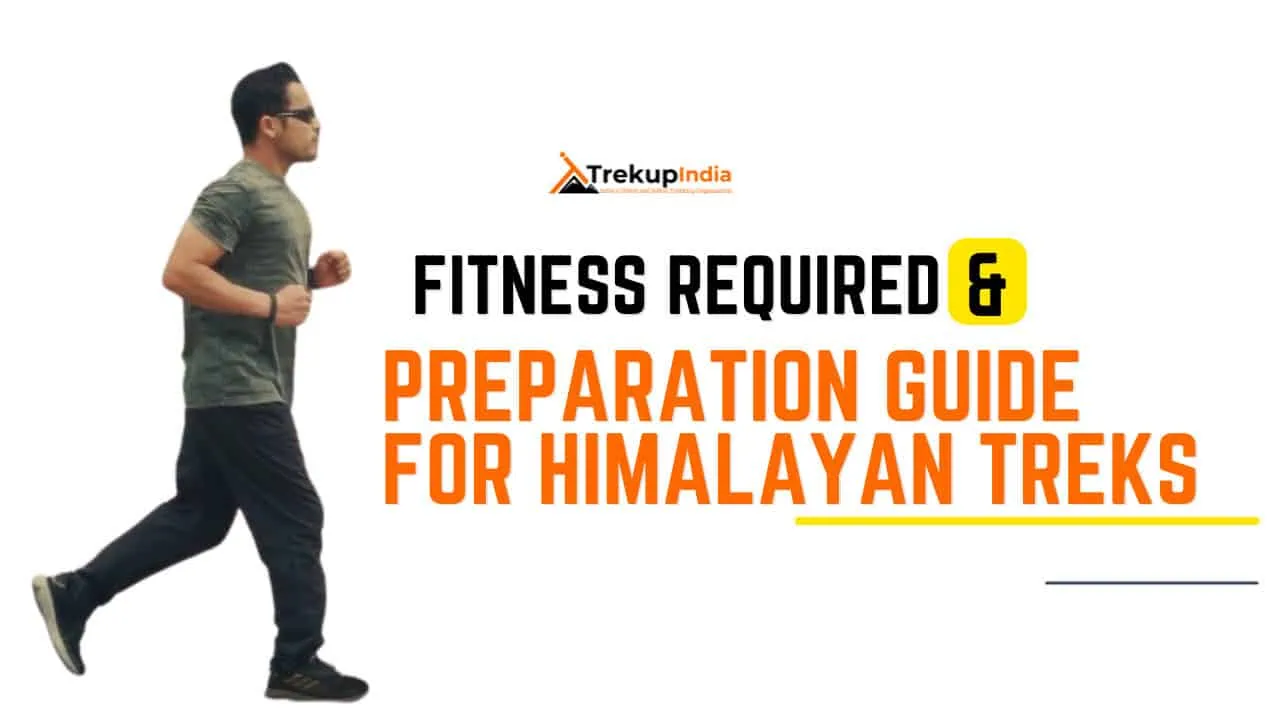
Fitness Target
Trekup India has put the Sandakphu Trek into an Moderate-Difficult grade level trek.
For Difficult – Challenging Treks – In order to be well-prepared for your upcoming trek, it is recommended that you focus on building your endurance by aiming to cover a distance of 5.5 kilometers in less than 45 minutes. This will help you to develop the necessary stamina and strength required to successfully complete your journey.
How to Achieve This Fitness Target?
To start preparing for your trek:
- Try jogging for at least five days every week.
- If you find 5 km too difficult at first, begin with 2 km and gradually increase over 2-3 weeks.
- Once you feel more comfortable running 5 km, focus on improving your speed gradually on a daily basis.
It is important to ensure that you can consistently complete 4.5 km in under 40 minutes for at least two weeks before your planned trek. Allow yourself 6-8 weeks to prepare physically for the journey.
Strength Training exercises that benefit Trekking
Trekking is an activity that demands a good level of strength.
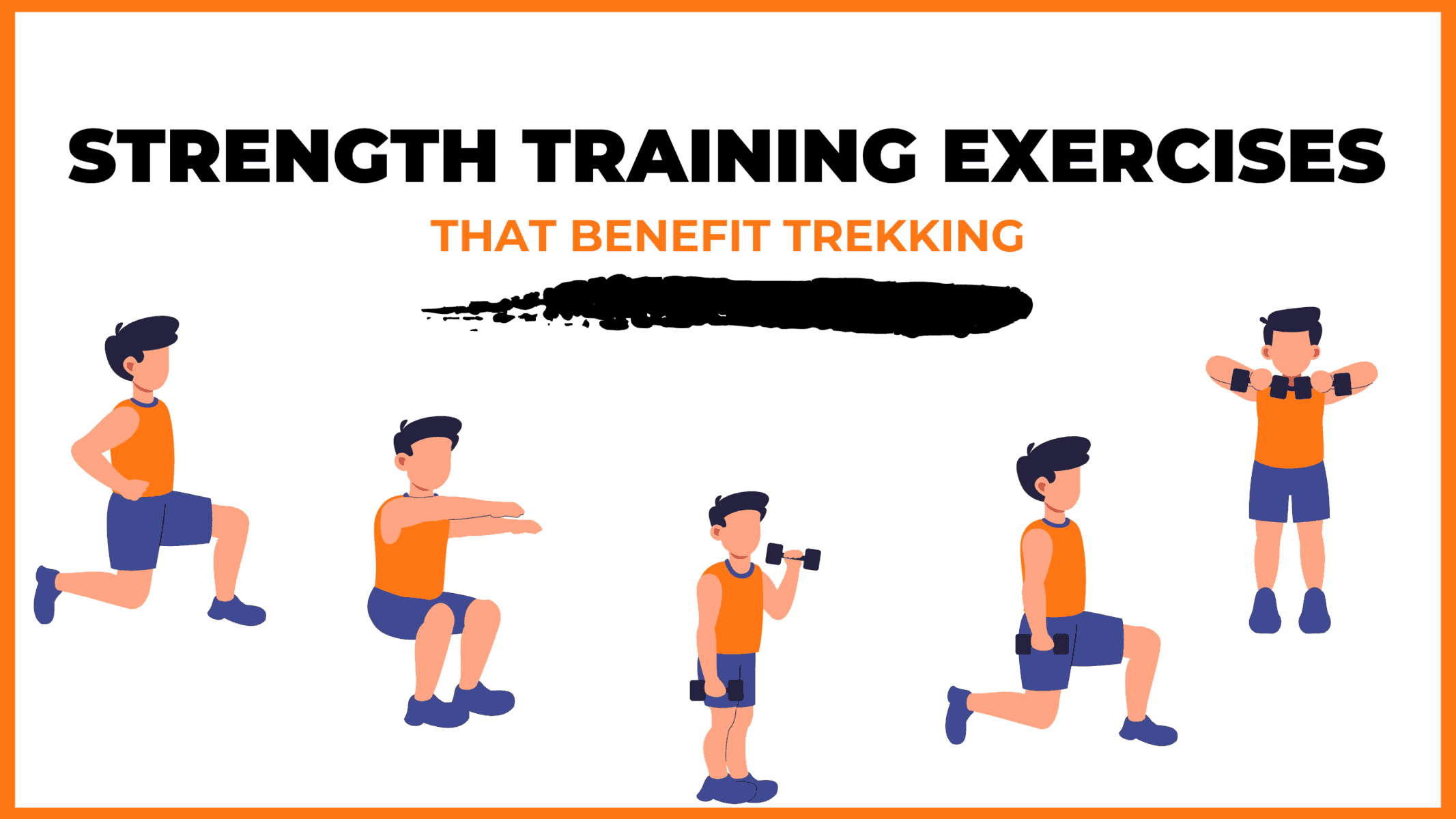
Trekking is a demanding activity that requires good cardiovascular endurance, muscular strength, and overall fitness. To help you prepare for your trek, incorporating bodyweight exercises into your training routine can be an effective way to build strength, improve stability, and enhance endurance, all of which are crucial for a successful trek. In this regard, here’s a breakdown of body weight exercises categorized by the specific body parts they target and the benefits they offer during trekking.
1. Lower Body Exercises
Lower body exercises like squats and lunges are great for building lower body strength, essential for trekking.
a. Squats
Squats are an excellent exercise for building lower body strength, essential for trekking. They target the quadriceps, hamstrings, glutes, and calves. Solid quadriceps and glutes provide power for ascending and tackling uphill climbs, while vital hamstrings aid stability during descents. This is particularly helpful in navigating uneven terrain during trekking.
How to perform Squats Exercises:
- Stand with feet shoulder-width apart, toes pointing slightly outward.
- Lower your body by bending your knees and hips, keeping your back straight.
- Lower until your thighs are parallel to the ground or as low as comfortable.
- Push through your heels to return to the starting position.
b. Lunges
Lunges target the quadriceps, hamstrings, glutes, and calves. They improve lower body strength, balance, and stability, crucial for maintaining control on rocky trails and steep slopes. Additionally, they enhance flexibility, reducing the risk of injury while trekking.
How to Perform Lunge Exercises:
- Stand with feet hip-width apart, hands on hips or sides.
- Take a step forward with one foot, lowering your body until both knees are bent at 90-degree angles.
- Push through the heel of your front foot to return to the starting position.
- Repeat on the other side, alternating legs.
2. Upper Body Exercises
Upper body exercises such as push-ups and pull-ups effectively strengthen the upper body, especially the chest and shoulders, which are essential for carrying a backpack during treks.
a. Push-Ups
Targets: Chest, shoulders, triceps, and core.
Benefits for Trekking: Push-ups are an effective exercise to strengthen the upper body, especially the chest and shoulders, essential for carrying a backpack during treks. Improved upper body strength will also help maintain posture and stability while traversing challenging terrain.
How to Perform Push-Ups Exercises:
- Start in a plank position with hands shoulder-width apart and body in a straight line from head to heels.
- Lower your body by bending your elbows until your chest nearly touches the ground.
- Push through your palms to return to the starting position.
- Keep your core engaged throughout the movement.
b. Pull-Ups/Bodyweight Rows:
Targeting the back, biceps, and shoulders can significantly benefit trekking. You can strengthen these muscle groups by performing pull-ups or bodyweight rows and improve your posture and balance while carrying a backpack. Additionally, more muscular back muscles can help reduce the risk of back strain and fatigue during long treks, making your journey safer and more comfortable.
3. Core Exercises
Core exercises like planks and Russian twists can help strengthen the core muscles, which are crucial for maintaining stability and balance while trekking on uneven terrain.
a. Planks
Targets: Abdominals, obliques, and lower back.
Benefits for Trekking: Planks are an effective exercise that helps strengthen the core muscles. These muscles are crucial for maintaining stability and balance while trekking on uneven terrain. A strong core also helps improve posture, reducing the risk of back pain and fatigue during extended hikes.
How to Perform Planks Exercises:
- Start in a plank position with elbows directly under shoulders and body in a straight line from head to heels.
- Engage your core and hold the position, avoiding sagging or arching the back.
- Keep breathing steadily and hold for the desired duration.
b. Russian Twists
Targets: Obliques, abdominals, and lower back.
Benefits for Trekking: Russian twists engage the core muscles, particularly the obliques, improving rotational stability and balance. Enhanced core strength helps prevent injuries and improves overall performance during trekking.
How to Perform Russian Twist Exercises:
- Sit on the ground with knees bent and feet flat, leaning back slightly to engage the core.
- Clasp hands together and twist the torso to one side, bringing the hands towards the ground beside the hip.
- Return to the centre, then twist to the other side.
- Continue alternating sides for the desired number of repetitions.
4. Full Body/Cardiovascular Exercises
Full-body/cardiovascular exercises like burpees and mountain climbers are excellent for improving cardiovascular endurance, strength, and agility.
a.Burpees
Burpees are an excellent full-body exercise that targets your legs, chest, arms, and core. This exercise dramatically benefits trekking enthusiasts, improving cardiovascular endurance, strength, and agility. Regularly incorporating burpees into your workout routine can enhance your overall fitness level, which can help you endure long hikes and rugged terrains with ease.
How to Perform Burpees Exercises:
- Start in a standing position.
- Squat down and place hands on the ground.
- Jump feet back into a plank position.
- Perform a push-up.
- Jump feet back to the squat position.
- Explosively jump up into the air, reaching overhead.
- Land softly and repeat the sequence.
b. Mountain Climbers
Mountain climbers target the core, shoulders, chest, and legs. This dynamic, full-body exercise can significantly improve cardiovascular endurance and agility. It is an excellent functional workout for trekking preparation as it engages both the upper and lower body muscles while strengthening the core muscles.
How to Perform Mountain Climbers Exercises:
- Start in a plank position with hands shoulder-width apart and body in a straight line from head to heels.
- Drive one knee towards the chest, then quickly switch legs, alternating in a running motion.
- Keep the core engaged and the hips stable throughout the movement.
- Continue at a moderate to fast pace for the desired duration.
Incorporating bodyweight exercises into your training routine can help you build strength and endurance and prepare your body for the physical demands of trekking. Consistency and proper form are crucial to maximizing the benefits of these exercises and ensuring a safe and enjoyable trekking experience. Engaging your core muscles, including obliques, abdominals, and lower back, with Russian twists can improve your rotational stability and balance, preventing injuries and enhancing overall performance during trekking.
When incorporating strength training exercises into your workout routine, it’s essential to maintain proper form and technique to avoid injury. Start with lighter weights and gradually increase the intensity as you progress, focusing on compound exercises targeting multiple muscle groups simultaneously. Some examples of practical strength training exercises for trekking include squats, lunges, deadlifts, and pull-ups.
Remember to give your muscles time to recover between workouts, and remember to stretch before and after your workouts to prevent injury and improve flexibility. Combining strength training with jogging and proper stretching allows you to take your fitness to the next level and confidently tackle even the most challenging treks.
Our Trekkers Reviews And Expreinces
We provide only Indian vegetarian food, and your meal will mainly consist of Indian bread, vegetables, lentils, rice, and a delicious dessert. During your trek, we will serve three meals a day, including breakfast, lunch, and dinner. You will also be served tea, snacks, and lip-smacking soup in the evening before dinner. If it is a long day of trekking, you will be given a packed snack.
After extensive research on the trekkers’ nutritional requirements, we prepare the menu. Before putting all the meals together, we also consider the altitude and the weather.
The meal we serve during the trek is perfectly balanced with calories, carbohydrates, vitamins, protein, fibre, and minerals. You need to know that all our cooks have great expertise in cooking and have undergone thorough training. So, get ready to enjoy delectable and lip-smacking dishes during your trek. You will be served with lemon tea in the tent to start your day with a refreshed feeling. Before leaving the campsite for trekking, you will be given a hot finger-licking breakfast like upma, Aallu Prantha, Besan Chilla, Poha, Daliya, Corn flakes, and Maggie, along with tea or coffee.
If your trek is longer, we also offer some fresh local fruits such as apples and healthy drinks like Frootie or Maaza. In the afternoon, you will be served a simple & healthy lunch, while at around 04:00 pm, you will be given tea and a light evening breakfast. After you reach your campsite at night, you will be served a hot and delightful dinner.
After reading this, you must have understood the food we provided on the trek; you don’t need to worry about food. Many trekkers repeatedly trek with us because of the food we provide. Thus, we will give you unforgettable experiences.

Trekking with us for the sandakphu trek is entirely safe because we have a team of trek leaders qualified in Wilderness first-aid and complete information about the high-altitude glitches. During the trek, we carry a full first-aid kit that contains all the essential medicines. Before trekking with us, you must ensure that you are medically fit for the trek; for us, your medical fitness is more important than anything else.
Right from our establishment, we at Trekup India have been continuously introducing new safety practices into Indian trekking to ensure the safety of voyagers. Trekup India introduced microspikes and made emergency bottled oxygen mandatory for all treks. Our trek leaders take your daily Pulse oximeter reading. We at Trekup India introduced the radio walkie-talkie as a safety communication device.
How can we ensure that your trek is safe with us?
We have noticed that most trek-organizing organizations do not follow these systems, but with time, they are following us; several competing companies are adopting these practices and organizing great, safe treks.
We ensure complete technical safety in the mountain. Our company has a vast team of more than 100 guides and trek leaders who serve on Himalayan treks. One of the best things about our team is that all the members are trained professionally by the Nehru Institute of Mountaineering, Indian Mountaineering Foundation Delhi, and Hanifle Center Outdoor Education Mussoorie.
Explore our New Safety Protocols
To ensure a perfect Trek, we have introduced some new safety checks to ensure excellent safety for our trekkers.
Our On-trek safety checks include:
- Daily oxygen saturation, along with pulse readings
- Stretchers team appointed on every trek
- Radios
- Trained mountain staff and complete safety
- Additional oxygen cylinders
- Special medical kit for high-altitude treks
- Microspikes on all types of snow treks
- Experienced Trek leaders, as well as safety
- Technical team on all snowy slopes
For Us, Your Safety Is the Top Priority
At Trekup India, you will find a team with local knowledge and fluency in English and Hindi. This helps ensure that you have a fantastic trek. Not only this, but we also pay attention to your health and safety because this is something we cannot ignore. All the team leaders involved in trekking have already undergone several professional courses in first aid, portable altitude chamber training, CPR, environmental awareness training, and advanced wilderness emergency medicine.
We also carry a complete first aid medical kit on every trek and trip we organize. Apart from the medical kit, we take a portable altitude chamber (if needed) and medical oxygen for all high-altitude treks. Our company has significant expertise in organizing all sorts of group adventure holidays for family groups, school and college groups, and friend groups. We have many travel options that suit different fitness levels and travelling styles.
Regardless of the group size, we value each and every member of our trekking groups. Our commitment to personal attention ensures that your needs and safety are always our top priority.
Who we are?
Trekup India has been a stalwart in the Adventure Tourism industry for 30 years. Since our inception, we have been dedicated to providing top-notch treks, voyages, trekking programs, and high-altitude expeditions. Our extensive experience is a testament to our commitment to your adventure and safety.
We organize treks in Uttarakhand, Kashmir, Sikkim, and Himachal while being part of the trekking community; we feature more than 75 documented Himalayan treks. In addition to other outdoor activities, our company also organizes trips for schools, colleges, and families.
Therefore, we maintain the quality of services offered to our valuable customers.
Must Read These Information Of Sandakphu Phalut Trek
Why You Should Do Sandakphu Phalut Trek
Sandakphu Trek is a must-do trek as on this; you come close to the world’s highest peaks. One of the famous sights on this trek is the Buddha Formation. Also, enjoy nature at its best as it lies in the Singallia National Park. The trekker learns about the local lifestyle by seeing the architecture of houses, monasteries, and locals in their day-to-day activities.
A stunning view of the world’s tallest mountain peaks.The picture-perfect sight of four of the world’s tallest mountains in Nepal, Bhutan, and Tibet. The peaks that will be visible are Mount Everest, Lhotse, Makalu and Kanchenjunga. Snowline
1.Get enthralled by the sight of flora and fauna.
The trek is in Singallia National Park, which is rich in biodiversity as you see Magnolias and Rhododendrons. The flowers add to the scenic views of pink, red, scarlet, and yellow hills. Get astonished at the sight of Himalayan black bears and Red Panda jumping on trees in the National Park.
2. “Sleeping Buddha” is a famous peak that is uniquely shaped.
The famous sight of the Buddha Formation is another picturesque sight on this trek. Sleeping Buddha holds significant meaning and importance in Buddhism. This stance mainly implies eternal peace and tranquility. The four tallest mountains form the famous “Sleeping Buddha.”
3. Remote Villages of the Himalayan region.
On the trek, you would see quaint Himalayan villages where people live in the winter season. You would come close to the lifestyle of local villagers, who depend greatly on tourism.
4. Drive through the well-known tea estates of Darjeeling and Sikkim.
You will have the opportunity to tour the native tea gardens of Darjeeling and Sikkim and experience.
Best time to do Sandakphu Trek
The best time to do this trek is between January to April and September to December. In the spring season, the temperature during the day is between 15 to 20 degrees Celsius, and at night it drops to 1 to 5 degrees Celsius. In the autumn, the temperature ranges between 13 to 18 degrees Celsius during the day, and if it rains, the temperature may drop to 1 to 12 degrees Celsius. In the winter, the temperature remains between 8 to 12 degrees Celsius; at night, it remains at 0 degrees Celsius and sometimes drops below 0 degrees Celsius. In winter, the trekker gets to experience snow mildly; spring brings color with it, whether it is white Magnolia flowers or trees of Rhododendron in pink and red. The landscape turns golden in autumn, and you see the unmistakable sight of peaks.
How Difficult is the Sandakphu Phalut Trek
The Sandakphu-Phalut Trek, a moderate trek by specific criteria, ensures your safety throughout the journey. It involves slightly challenging and uneven trails, trekking for up to 6 hours daily, and requires good cardiovascular fitness. The trek meets all these criteria without any technical or complicated sections. Beginners and experienced trekkers can do this trek, reaching an altitude of 12,000 ft. The route is well-established, being one of the oldest trekking trails in India. However, there are some challenging sections on this trek, such as the steep ascent from Sepi to Rammam village, the climb from Samanden to Molley, and the descent from Sandakphu to Gurdum, which can be slippery and tricky in rainy or snowy conditions.
Mythological Stories About Sandakphu Trek
A conflict erupted between Nepal and Sikkim, resulting in Nepal’s capture of Darjeeling, which was previously under Sikkim’s jurisdiction. In the face of this upheaval, the Nepalese settlers, known as Gorkhas, migrated to the Darjeeling region. Simultaneously, the British were also making their presence felt in the area. To avert potential attacks, Nepal made the strategic decision to relinquish control of Darjeeling to the British as a gift. This move ensured that Nepal remained one of the few countries the British never colonized. Despite Nepal being predominantly Hindu, the culture in Darjeeling is a fascinating blend of Buddhist practices and strong influences from traditional Tibetan customs. A striking sight in sacred and historic sites are the five-coloured flags, symbolizing the elements of earth, water, air, fire, and space. The locals believe their prayers are carried far and wide by the wind as the flags wave, spreading their messages afar.
Frequently Asked Questions About Sandakphu Phalut Trek
Is Sandakphu Suitable for Beginners?
The Sandakphu Phalut trek is an excellent choice for those new to trekking, but it does demand a reasonable level of physical fitness as it includes moderately long daily walks. The trek spans six days and covers a total distance of 63 kilometres, with an average of around 10 kilometres per day. To ensure a comfortable and successful journey, it’s recommended that you walk 5 kilometres in 40-45 minutes before starting the trek.
Where is Sandakphu Phalut Trekking?
This trek is in West Bengal, in India’s Eastern Himalayas. Sandakphu is considered its top peak. Trekkers begin their trek from Jaubhari village.
Why should I do this Trek?
Sandakphu can be described as the epitome of Himalayan beauty, boasting snow-clad mountains, lush green valleys, and picturesque high-altitude towns. As West Bengal’s tallest peak at 3,627 meters, Sandakphu enjoys all of the advantages that go along with being at its centre; here lies one of its imposing mountains: right before your very eyes. Sandakphu stands as one of the few moderate-level trekking routes that provides such stunning panoramic views, situated among Mount Everest, Kangchenjunga, Lhotse, and Makalu – The Big Four of Nepal! Furthermore, it places you between three 8,000-meter peaks. Sandakphu passes through Singalila National Park, one of the world’s greatest biodiversity hotspots and home to an incredible variety of flora and fauna – you might even catch sight of a Red Panda or some rare Himalayan birds. This trek is ideal for beginners, offering challenging terrain with beautiful sights. Plus, with warm beds and indoor comfort available as support, your journey won’t leave you exhausted.
What are the challenges involved with the Sandakphu Phalut trek?
This is an intriguing question. Although the trek won’t lead to high altitudes or require rapid elevation gains, its difficulty remains significant and time-consuming. Sandakphu offers its own set of challenges, such as extremely long daily distances and ascents that are steep, as well as unpredictable weather that could turn an otherwise sunny and warm day into an unexpected shower; plus, very unpredictable treks, which could become treacherously cold depending on when and why one takes this trek. For more insight into what challenges this route holds out, take a look at what the purpose is for taking this trek, or check out what the purpose is of taking this climb! For further insights into these obstacles that await you, take a look at Who Are They Climbing This Climb and Why Climbers Do Climbs: Climbers Who Climb Climbers For Further insight into what their motivations are when undertaking such a climb. To better understand these difficulties associated with this climb, take a look at the purpose for taking this Climb is undertaken? For further understanding regarding its challenges, take a look at Who are these climbers doing this climb Is this climb? To gain more details on this topic, take a look at Who’s Purpose Climb? For additional details regarding its challenges, see: Who Are Climbers? Climb this Route and Why Climb? For additional insight as to Whom They Climb this Route Climb this Climb or for more details consider this Climb. For additional info, see Who’s the Purpose behind This Climb, by checking Who’s the purpose? For information as this Climb;
What is the best time of year for this trek?
Sandakphu can be reached throughout the year, with monsoons as a barrier. Spring (March through May) features vibrantly-hued rhododendron blooms; Autumn and winter (September until February) offer spectacular mountain vistas; while any time between those months won’t disappoint either with dry conditions and breathtaking Himalayan mountain views that never fail to impress! Pick your month and don’t be dissatisfied results!
What's the Weather Like Here?
Between March and May, temperatures tend to remain between 10 °C and 20degC; night time lows generally range between 5degC and 10degC. Mid-September to mid-November is typically cool and dry, with daytime temperatures typically reaching 5degC to 15 °C, and night temperatures typically falling within the 0degC to 5degC range.
What Should I Bring For My Trek?
Before embarking on any Himalayan excursion, make sure you bring all of the essential items. Don’t forget rain gear since skies may quickly change colour!
What Is the Sleeping Buddha?
It is believed that the Sleeping Buddha is one of the main attractions at the Sandakphu trek. The area features mountains resembling precisely proportioned images of sleeping Buddha figures, making its presence obvious! You won’t even need your eyes closed to spot this sight. The Kangchenjunga Mountain range gives this trek its name, and its beauty can be found many times throughout. Even if you try, you simply can’t miss this sight.
What Is the Difference between Sandakphu and Goechala Treks in Eastern Nepal?
These two treks share many similarities in terms of scenery, terrain, flora, and fauna, but also differ substantially when it comes to duration, difficulty, and elevation gain. Sandakphu can be enjoyed by novice and experienced trekkers alike, while Goechala requires prior experience with high-altitude trekking to make the experience comfortable and pleasant. To learn more, please see: Sandakphu or Goechala, Which Should You Choose?
Can You Enjoy a Fantastic Family Outing on the Sandakphu Trek for Novices?
As it’s designed as a trek for beginners, no prior knowledge is necessary. But mental preparation and endurance should be in place before setting out on your journey. Sandakphu does not require camping experience and provides homestays instead for its duration, making this trek slightly less daunting when compared with other Himalayan treks. One thing to be mindful of, however, is its typical 15 km days that make up this trek compared with other Himalayan treks.
Will I Need An Instruction Manual For This Trek?
Not necessarily; most treks feature marked treks and roadways to assist, as well as comfortable homestays to rest at along your trek route. Sandakphu is one such trek you can complete on your own without children being present – check it out today.
Travel guidebooks can make life much simpler when traveling through the Himalayas, assisting with getting necessary permits, ease of navigation, and booking homestays with good reputations, as well as carrying your load, an aspect that may become challenging on its own.
Is This Trek Reasonable?
That depends entirely on what your expectations of trekking are. In terms of splendour and grandeur of being among some of the world’s greatest mountains, including those spanning India-Nepal boundaries, then yes, it likely makes sense.
The top of the trek may become congested on weekends due to being easily accessible via motorways; however, its journey itself remains free from crowds.
What is the Time Frame to Complete my Trek?
From Bagdogra to Bagdogra, the trek will last seven days in duration.
How can I reach the village at the start or finish of my trek?
For the Sandakphu trek, Jaubhari serves as its starting point, and Bagdogra airport is 100 km away. Here’s more information on how you can reach Jaubhari.
What nearby sights should I visit before or after trekking? There are numerous local landmarks you could visit before or after your trek; here are a few of the more well-known options:
Singalila National Park: Singalila National Park is situated within the Darjeeling district and boasts an array of wildlife and plants such as red pandas, musk deer’s and black bears. Furthermore, this national park is known for offering beautiful panoramic views of the Kangchenjunga and Mount Everest ranges.
Darjeeling: Darjeeling is an acclaimed tourist destination renowned for its tea plants, colonial-style architecture, and breathtaking vistas of the Himalayas. Visitors can take a scenic train journey on the Darjeeling Himalayan Railway – a UNESCO World Heritage Site – or explore Tibetan customs and culture at the Tibetan Refugee Self-Help Centre.
Mirik: Mirik is an attractive hill station situated 50 km (31 miles) north of Darjeeling. Mirik Lake provides fishing and boating activities, while orchards of oranges provide scenic backdrops.
Kalimpong: Kalimpong is a small town situated approximately 55km (34 miles) outside Darjeeling and known for its Buddhist temples, colonial structures, and stunning Himalayan panoramas. Visitors to this town may also explore the local nurseries of flowers and tea plants in this region.
Kurseong: Kurseong is a tranquil hill station situated approximately 32 kilometres (20 miles) west of Darjeeling. It is well known for its tea plants, beautiful views, and historic churches.
Why should I visit Sandakphu even though there is an accessible motorable road leading directly there?
Sandakphu offers an easily accessible motorized road leading directly to its summit, and you may decide to use it. But in doing so, you will miss the splendour that lies within Singalila National Park trees – lush rhododendron bloom, stone treks and wood scent as well as bird chirps are just some of the wonders you could experience along this way; flirtations with borders; small high-altitude communities with warm welcome of hosts in guesthouses are lost too – not forgetting Phalut’s majestic splendour! Our conclusion would be: If this journey could last seven days, why limit it?
Sandakphu offers more to experience through its scenery and route than through any final viewpoint at its summit.



